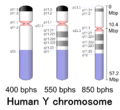Y chromosome: Difference between revisions
CSV import Tags: mobile edit mobile web edit |
CSV import |
||
| Line 28: | Line 28: | ||
[[Category:Y chromosome]] | [[Category:Y chromosome]] | ||
{{genetics-stub}} | {{genetics-stub}} | ||
<gallery> | |||
File:Human_male_karyotpe_high_resolution_-_Y_chromosome_cropped.png|Y chromosome high resolution | |||
File:Human_male_karyotpe_high_resolution_-_Chromosome_Y.png|Chromosome Y | |||
File:Human_chromosome_Y_ideogram_vertical.svg|Human chromosome Y ideogram | |||
File:Human_chromosome_Y_-_400_550_850_bphs.png|Human chromosome Y at different banding resolutions | |||
</gallery> | |||
Latest revision as of 04:35, 18 February 2025
Y chromosome is one of the two sex chromosomes in mammals, including humans, and many other animals. The other is the X chromosome. Y chromosome is the sex-determining chromosome in many species, since it carries the genes responsible for male development.
Characteristics[edit]
The Y chromosome is one of the smallest human chromosomes. It represents about 2% of the total DNA in cells. Despite its small size, the Y chromosome has a crucial role in the body. It carries the genes that determine male sex. These genes are involved in the development of male gonads, the production of sperm, and the development of male secondary sexual characteristics at puberty.
Genetic content[edit]
The Y chromosome contains about 200 genes. The most important of these is the SRY gene, which initiates the process of male sex determination. Other genes on the Y chromosome are involved in spermatogenesis, the process by which sperm are produced.
Evolution[edit]
The Y chromosome has a unique mode of evolution. Unlike other chromosomes, which undergo recombination, the Y chromosome is passed on almost unchanged from father to son. This makes the Y chromosome a useful tool in genetic genealogy, the study of ancestry and family history using DNA.
Y chromosome in genetic genealogy[edit]
In genetic genealogy, the Y chromosome is used to trace paternal lineage. This is possible because the Y chromosome is passed down almost unchanged from father to son. Changes, or mutations, in the Y chromosome can be used to trace the history of a male lineage.
See also[edit]
-
Y chromosome high resolution
-
Chromosome Y
-
Human chromosome Y ideogram
-
Human chromosome Y at different banding resolutions



